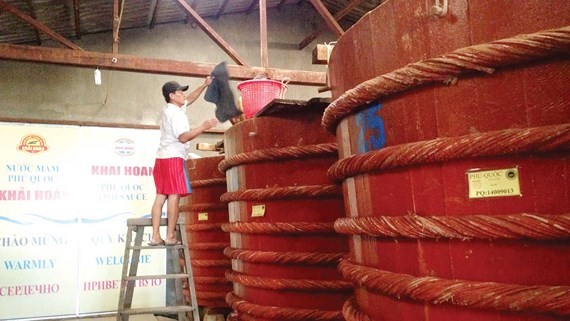
For a long time, the name ‘fish sauce’ has been misused by famous industrial food manufacturers for their industrial fish sauces – a mixture of fish essence, flavoring, coloring, preservatives and sweeteners - to fool consumers into thinking that their products are made from fish and blur the differences between industrial fish sauce and traditional one. However, the name ‘fish sauce’ can only be used for the liquid that is made from fish and salt. A mixture of diluted fish sauce and additives cannot be called ‘fish sauce’. That is the reason why traditional fish sauce makers have been opposing to a draft on new standards for fish sauce production practices built by the Agro Processing and Market Development Authority under the Ministry of Agriculture and Rural Development which equates traditional fish sauce with industrial one and has many criteria that favor industrial fish sauce.
Traditional fish sauce cannot be regarded as the same as industrial fish sauce because it takes up to two years for traditional fish sauce makers to make fish sauce purely from fish and salt. Meanwhile, with just a few tanks, industrial fish sauce makers can make up to hundreds of thousands of liters of industrial fish sauce a day from water and chemicals.
Traditional fish sauce is free from preservative as salt and high amino acid content has helped to preserve the liquid naturally. Meanwhile, industrial fish sauce - a mixture of diluted fish sauce and chemicals – can never be considered as fish sauce but dipping sauce. Traditional fish sauce makers just want to get back the name of fish sauce and do not want authority to lead the traditional fish sauce production to another direction and equate traditionally made fish sauce with industrial one.
The draft is said to be not compulsory but its purpose is dubious. In the draft, there are up to 50 regulations and terms that are vague and inappropriate to the actual fish sauce production and even cause difficulties for traditional fish sauce production.
For instance, they require control on veterinary and plant protection drugs while the main ingredient to make fish sauce is saltwater fish instead of freshwater fish or farmed fish. As for some traditional fish sauce made from freshwater fish, the material is byproduct of pangasius fish for export which has already met food safety standards. Therefore, control on this criterion is unnecessary.
The criterion about clostridium botulinum is totally wrong because this kind of bacteria cannot survive in fish sauce environment. Especially, control on histamine is unfeasible as traditional fish sauce is mainly made from anchovies which are caught in the course of the day and have tiny intestine so the amount of histamine is negligible.
Such useless regulations of the draft will waste money and time of fish sauce makers in verifying criteria that do not affect the hygiene and safety of fish sauce.
Although the draft is not compulsive, it raised concerns that someone is using the power of authority to mingle the differences between traditional fish sauce and industrial one. It is nonsense to apply the standards of Thailand, whose fish sauce makers do not make fish sauce in the same way as Vietnamese ones, on traditionally-made fish sauce of Vietnam. Thailand’s fish sauces are diluted fish sauce mixed with chemicals so their nitrogen level can never be higher than 20N whereas Vietnam’s traditional fish sauces are made from fish and salt so they have an average nitrogen level of 20-30N and some up to 42-43N. The higher nitrogen level is, the more fish are used which means higher level of histamine. If the regulation on histamine level that should not exceed 400 milligrams per liter is passed, it will shut down all traditional fish sauce makers and there will be only industrial fish sauce left.
Traditional fish sauce makers are allowed to produce fish sauce by local authority because they have met standards on food safety and have been doing very well in maintaining these standards. It is essential to separate industrial fish sauce from traditional fish sauce and give back the name fish sauce to traditionally-made kind before making any regulations or standards on fish sauce.

Traditional fish sauce production in Phu Quoc Province. (Photo: SGGP)

Traditional fish sauce production in Phu Quoc Province. (Photo: SGGP)
























